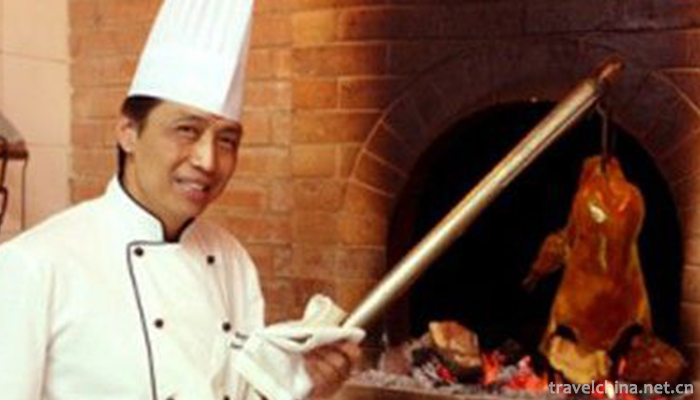Roast duck skills
Roast duck skills
Quanjude hanging oven roast duck is a local traditional handicraft in Beijing. Quanjude Roast Duck Restaurant, a well-known old Chinese brand in Beijing, was founded in 1864 by Yang Quanren. Yang Quanren employs famous Shandong chefs to refine roast duck with the technology of hanging oven roast duck circulated from Imperial Palace Dining room, which has a growing reputation. The hanging oven roast duck uses fruit trees as fuel and is roasted over open fire in a special oven. Quanjude Roast Duck, with its crisp skin, tender meat, bright color, fragrant smell, is well known at home and abroad, and is listed as the top specialty of the capital.
Detailed introduction
Quanjude Roast Duck is well-known as the representative of Beijing Roast Duck because it has three characteristics: first, it has high quality raw material Beijing Roast Duck. Secondly, its processing equipment is advanced. Finally, it has a unique flavor.
According to the scientific determination of relevant departments. Most of the fat in Beijing duck is evenly distributed in the texture of muscle tissue, which is an important reason for the tender meat and delicious taste of roast duck.
Quanjude Roast Duck has a complete set of interlocking roasting processes: slaughter, scalding, hairing, blowing, opening, cutting, support, hearth washing, hooking, drying, scalding, sugar, re-drying (above is the process of blanking), clogging, filling, entering the oven, crotch, rotating, out of the oven (above is the process of roasting), and so on.
Quanjude roast duck is also very good at eating, wrapped in lotus leaf cake, with sweet paste, onion or cucumber strips, crisp and delicate, set in a roll, and can also be roast duck dipped in sweet paste, with onion strips stuffed into hollow sesame barbecue to eat. In addition, "Quanjude" also pioneered the whole duck dish.
After the founding of New China, with the concern of the Party and the government, "Quanjude" got rid of the danger of bankruptcy, gradually from weak to strong, to prosperity. In April 2004, Quanjude Group implemented strong alliance, asset restructuring and established China Quanjude (Group) Co., Ltd. Since then, Quanjude has entered a new stage of development.


-
1.Beef noodle
Beef noodle is a common pasta. It is also a traditional food in Lanzhou
Time 2018-10-12 -
2.Jinsi Gorge Scenic Area
Jinsi Gorge Scenic Area of Shangluo City, Shaanxi Province, is located in the hinterland of Xinkailing in the southeast of Shangnan County, Shangluo City.
Time 2018-12-12 -
3.Mupa Mipa
Mupa Mipa, a local traditional folk literature in Simao City, Yunnan Province, is one of the national intangible cultural heritage.
Time 2018-12-15 -
4.Changying Century City
Changying Century City, located in Nanguan District, Changchun City, Jilin Province, was founded in 2003. It is a comprehensive tourist area integrating science and technology, adventure, performing a
Time 2019-03-17 -
5.Jiaodong drum
Jiaodong Drum is a folk folk folk art form which originated in the coastal counties of Jiaodong Peninsula. It has a history of more than 260 years so far. It originated from the blind
Time 2019-05-06 -
6.Lv Jiahe Folk Song
Lvjiahe Folk Song is a kind of folk song which is popular in Lvjiahe Village, Guanshan Town, Danjiangkou City, Hubei Province. Located in Wudang Mountain Scenic Area, the village retains a large numbe
Time 2019-05-15 -
7.Miao brocade weaving skills
Miao brocade is woven by Miao women using silk, ramie, kapok and other fibers produced locally. Miao brocade, also known as weaving flowers, is a pattern fabric formed by weaving. The color weft is fu
Time 2019-06-05 -
8.Running curtain
Running curtain originated in the Spring and Autumn Period and Warring States Period, formed in the Qin and Han Dynasties, flourished in the Song, Yuan, Ming, Qing Dynasty and the early Republic of Ch
Time 2019-06-09 -
9.Tajik Folk Songs
Tajik folk songs are very rich in content. The folk songs handed down to this day include folk songs reflecting ancient social life, customs and customs, eulogizing love and religious rituals. The mai
Time 2019-06-17 -
10.Yao Opera
Yao Opera is popular in Yuyao, Cixi, Ningbo, Zhoushan, Shangyu and Shaoxing. It developed on the basis of folk singing and dancing "horse lantern", "dry boat" and "tea basket&
Time 2019-07-11 -
11.Genghis Khan Cheng Ji Si Han
He was a Jin Jin. He was from May 31, 1162 to August 25, 1227. Yeke Mongghol Ulus Khan, outstanding in world history. Politician , Militarist
Time 2019-09-07 -
12.Leshan social service
By the end of 2018, there were 13 social welfare homes in Leshan City with 2908 beds and 2182 people in the hospital. The sales of social welfare lottery tickets totaled 385.69 million yuan, raised 109.75 million yuan of welfare lottery public welfare fund,
Time 2020-12-17